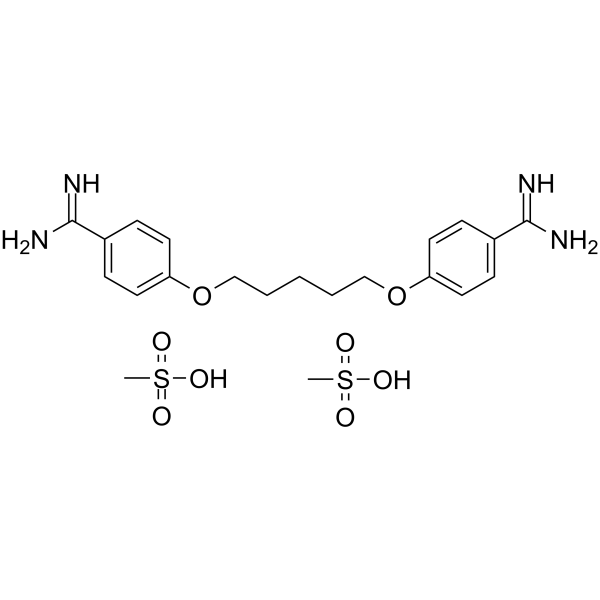| Description |
Pentamidine (MP-601205) dimesylate is an antimicrobial agent and interferes with DNA biosynthetics. Pentamidine dimesylate inhibits parasite Leishmania infantum with an IC50 of 2.5 μM. Pentamidine dimesylate is a potent and selective protein tyrosine phosphatases (PTPases) and phosphatase of regenerating liver (PRL) inhibitor. Pentamidine dimesylate has the potential for Gambian trypanosomiasis, antimony-resistant leishmaniasis, and Pneumocystis carinii pneumonia treatment. Antitumor and antibacterial activities[1][2][3][4].
|
| Related Catalog |
|
| In Vitro |
Pentamidine (0-10 µg/mL; 6 days; WM9, DU145, C4-2, Hey, WM480, and A549 cells) dimesylate treatment inhibits the growth of cancer cells in a concentration-dependent manner[1]. The cytotoxic properties of Pentamidine isethionate towards the promastigotes of the protozoan parasite Leishmania infantum is determined. The leishmanicidal activity of Pentamidine isethionate is 60 times higher after 72 h of incubation than that of Cisplatin. Pentamidine isethionate induces a higher amount of programmed cell death (PCD) than Cisplatin, which is associated with inhibition of DNA synthesis and cell-cycle arrest in the G2/M phase. Binding of Pentamidine isethionate to calf-thymus DNA (CT-DNA) induces conformational changes in the DNA double helix, consistent with a B-->A transition. The interaction of Pentamidine isethionate with ubiquitin leads to a 6% increase in the beta-sheet content of the protein[2]. Cell Viability Assay[1] Cell Line: WM9, DU145, C4-2, Hey, WM480, and A549 cells Concentration: 0-10 µg/mL Incubation Time: 6 days Result: The growth of all six of the cell lines in culture was inhibited in a concentration-dependent manner with complete growth inhibition of the cell lines occurring at 10 µg/mL.
|
| In Vivo |
Pentamidine (0.25 mg/mouse; intramuscular injection; every 2 days; for 4 weeks; athymic nude mice) dimesylate treatment markedly inhibits the growth of WM9 human melanoma tumors in nude mice[1]. Animal Model: Athymic nude mice (6 weeks old) injected with WM9 cells[1] Dosage: 0.25 mg/mouse Administration: Intramuscular injection; every 2 days; for 4 weeks Result: Markedly inhibited the growth of WM9 human melanoma tumors in nude mice.
|
| References |
[1]. Pathak MK, et al. Pentamidine is an inhibitor of PRL phosphatases with anticancer activity. Mol Cancer Ther. 2002 Dec;1(14):1255-64. [2]. Nguewa, P.A., et al., Pentamidine is an antiparasitic and apoptotic drug that selectively modifies ubiquitin. Chem Biodivers, 2005. 2(10): p. 1387-400. [3]. Sands M, et al. Pentamidine: a review. Rev Infect Dis. 1985 Sep-Oct;7(5):625-34. [4]. David C. Bean, et al. Pentamidine: a drug to consider re-purposing in the targeted treatment of multi-drug resistant bacterial infections? J Lab Precis Med 2017;2:49.
|
